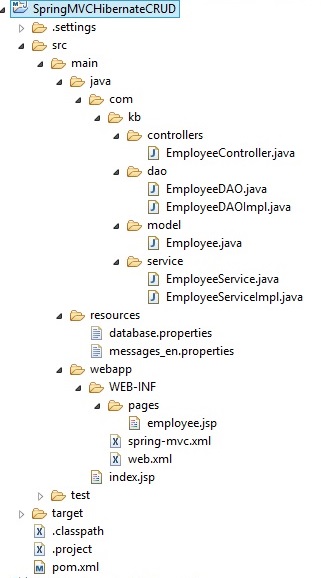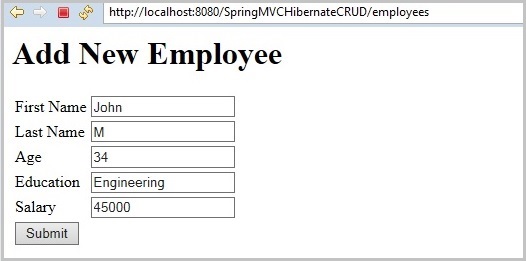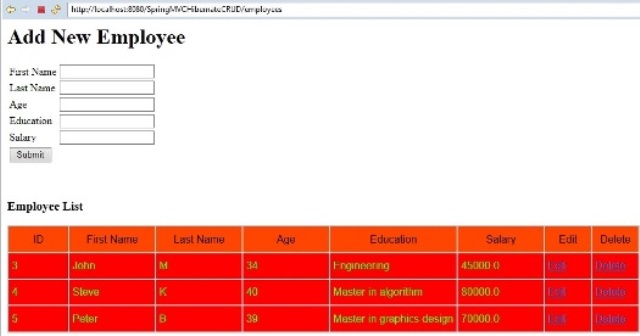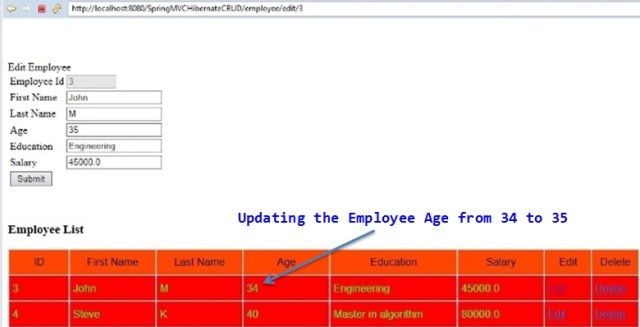Spring MVC with Hibernate CRUD example
In this article, We will learn about how to integrate Hibernate with Spring MVC application
Step 1
Create Spring MVC project, Please refer Spring MVC setup in eclipse article on how to do it.
Project structure

Step 2
Update pom.xml with required dependencies
- <project xmlns="http://maven.apache.org/POM/4.0.0" xmlns:xsi="http://www.w3.org/2001/XMLSchema-instance"
- xsi:schemaLocation="http://maven.apache.org/POM/4.0.0 http://maven.apache.org/maven-v4_0_0.xsd">
- <modelVersion>4.0.0</modelVersion>
- <groupId>SpringMVCHibernateCRUD</groupId>
- <artifactId>SpringMVCHibernateCRUD</artifactId>
- <packaging>war</packaging>
- <version>0.0.1-SNAPSHOT</version>
- <name>SpringMVCHibernateCRUD Maven Webapp</name>
- <url>http://maven.apache.org</url>
- <properties>
- <org.springframework.version>4.2.0.RELEASE</org.springframework.version>
- </properties>
- <dependencies>
- <dependency>
- <groupId>junit</groupId>
- <artifactId>junit</artifactId>
- <version>3.8.1</version>
- <scope>test</scope>
- </dependency>
- <dependency>
- <groupId>org.springframework</groupId>
- <artifactId>spring-webmvc</artifactId>
- <version>${org.springframework.version}</version>
- </dependency>
- <dependency>
- <groupId>org.hibernate</groupId>
- <artifactId>hibernate-core</artifactId>
- <version>5.2.6.Final</version>
- </dependency>
- <dependency>
- <groupId>mysql</groupId>
- <artifactId>mysql-connector-java</artifactId>
- <version>6.0.5</version>
- </dependency>
- <dependency>
- <groupId>org.springframework</groupId>
- <artifactId>spring-tx</artifactId>
- <version>${org.springframework.version}</version>
- </dependency>
- <dependency>
- <groupId>org.springframework</groupId>
- <artifactId>spring-orm</artifactId>
- <version>${org.springframework.version}</version>
- </dependency>
- <dependency>
- <groupId>javax.servlet</groupId>
- <artifactId>servlet-api</artifactId>
- <version>2.5</version>
- </dependency>
- <dependency>
- <groupId>javax.servlet.jsp</groupId>
- <artifactId>jsp-api</artifactId>
- <version>2.1</version>
- </dependency>
- <dependency>
- <groupId>javax.servlet</groupId>
- <artifactId>jstl</artifactId>
- <version>1.2</version>
- </dependency>
- </dependencies>
- <build>
- <finalName>SpringMVCHibernateCRUD</finalName>
- </build>
- </project>
<project xmlns="http://maven.apache.org/POM/4.0.0" xmlns:xsi="http://www.w3.org/2001/XMLSchema-instance"
xsi:schemaLocation="http://maven.apache.org/POM/4.0.0 http://maven.apache.org/maven-v4_0_0.xsd">
<modelVersion>4.0.0</modelVersion>
<groupId>SpringMVCHibernateCRUD</groupId>
<artifactId>SpringMVCHibernateCRUD</artifactId>
<packaging>war</packaging>
<version>0.0.1-SNAPSHOT</version>
<name>SpringMVCHibernateCRUD Maven Webapp</name>
<url>http://maven.apache.org</url>
<properties>
<org.springframework.version>4.2.0.RELEASE</org.springframework.version>
</properties>
<dependencies>
<dependency>
<groupId>junit</groupId>
<artifactId>junit</artifactId>
<version>3.8.1</version>
<scope>test</scope>
</dependency>
<dependency>
<groupId>org.springframework</groupId>
<artifactId>spring-webmvc</artifactId>
<version>${org.springframework.version}</version>
</dependency>
<dependency>
<groupId>org.hibernate</groupId>
<artifactId>hibernate-core</artifactId>
<version>5.2.6.Final</version>
</dependency>
<dependency>
<groupId>mysql</groupId>
<artifactId>mysql-connector-java</artifactId>
<version>6.0.5</version>
</dependency>
<dependency>
<groupId>org.springframework</groupId>
<artifactId>spring-tx</artifactId>
<version>${org.springframework.version}</version>
</dependency>
<dependency>
<groupId>org.springframework</groupId>
<artifactId>spring-orm</artifactId>
<version>${org.springframework.version}</version>
</dependency>
<dependency>
<groupId>javax.servlet</groupId>
<artifactId>servlet-api</artifactId>
<version>2.5</version>
</dependency>
<dependency>
<groupId>javax.servlet.jsp</groupId>
<artifactId>jsp-api</artifactId>
<version>2.1</version>
</dependency>
<dependency>
<groupId>javax.servlet</groupId>
<artifactId>jstl</artifactId>
<version>1.2</version>
</dependency>
</dependencies>
<build>
<finalName>SpringMVCHibernateCRUD</finalName>
</build>
</project>
Step 3
Update web.xml file with Dispatcher servlet
- <web-app xmlns="http://xmlns.jcp.org/xml/ns/javaee" xmlns:xsi="http://www.w3.org/2001/XMLSchema-instance"
- xsi:schemaLocation="http://xmlns.jcp.org/xml/ns/javaee http://xmlns.jcp.org/xml/ns/javaee/web-app_3_1.xsd"
- version="3.1">
- <display-name>Archetype Created Web Application</display-name>
- <!-- Spring MVC dispatcher servlet -->
- <servlet>
- <servlet-name>mvc-dispatcher</servlet-name>
- <servlet-class>org.springframework.web.servlet.DispatcherServlet</servlet-class>
- <init-param>
- <param-name>contextConfigLocation</param-name>
- <param-value>
- /WEB-INF/spring-mvc.xml
- </param-value>
- </init-param>
- <load-on-startup>1</load-on-startup>
- </servlet>
- <servlet-mapping>
- <servlet-name>mvc-dispatcher</servlet-name>
- <url-pattern>/</url-pattern>
- </servlet-mapping>
- <listener>
- <listener-class>org.springframework.web.context.ContextLoaderListener</listener-class>
- </listener>
- <context-param>
- <param-name>contextConfigLocation</param-name>
- <param-value>
- /WEB-INF/spring-mvc.xml
- </param-value>
- </context-param>
- </web-app>
<web-app xmlns="http://xmlns.jcp.org/xml/ns/javaee" xmlns:xsi="http://www.w3.org/2001/XMLSchema-instance"
xsi:schemaLocation="http://xmlns.jcp.org/xml/ns/javaee http://xmlns.jcp.org/xml/ns/javaee/web-app_3_1.xsd"
version="3.1">
<display-name>Archetype Created Web Application</display-name>
<!-- Spring MVC dispatcher servlet -->
<servlet>
<servlet-name>mvc-dispatcher</servlet-name>
<servlet-class>org.springframework.web.servlet.DispatcherServlet</servlet-class>
<init-param>
<param-name>contextConfigLocation</param-name>
<param-value>
/WEB-INF/spring-mvc.xml
</param-value>
</init-param>
<load-on-startup>1</load-on-startup>
</servlet>
<servlet-mapping>
<servlet-name>mvc-dispatcher</servlet-name>
<url-pattern>/</url-pattern>
</servlet-mapping>
<listener>
<listener-class>org.springframework.web.context.ContextLoaderListener</listener-class>
</listener>
<context-param>
<param-name>contextConfigLocation</param-name>
<param-value>
/WEB-INF/spring-mvc.xml
</param-value>
</context-param>
</web-app>
we have defined a dispatcher servlet in web.xml and mapped it by the URL pattern “/”
Step 4
Create the Employee class
- package com.kb.model;
- import javax.persistence.Column;
- import javax.persistence.Entity;
- import javax.persistence.GeneratedValue;
- import javax.persistence.GenerationType;
- import javax.persistence.Id;
- import javax.persistence.Table;
- @Entity
- @Table(name="Employee")
- public class Employee {
- @Id
- @GeneratedValue(strategy = GenerationType.SEQUENCE)
- @Column(name = "Employee_Id")
- private Integer employeeId;
- @Column(name = "FirstName")
- private String firstName;
- @Column(name = "LastName")
- private String lastName;
- @Column(name = "Age")
- private Integer age;
- @Column(name = "Education")
- private String education;
- @Column(name = "Salary")
- private Double salary;
- public Integer getEmployeeId() {
- return employeeId;
- }
- public void setEmployeeId(Integer employeeId) {
- this.employeeId = employeeId;
- }
- public String getFirstName() {
- return firstName;
- }
- public void setFirstName(String firstName) {
- this.firstName = firstName;
- }
- public String getLastName() {
- return lastName;
- }
- public void setLastName(String lastName) {
- this.lastName = lastName;
- }
- public Integer getAge() {
- return age;
- }
- public void setAge(Integer age) {
- this.age = age;
- }
- public String getEducation() {
- return education;
- }
- public void setEducation(String education) {
- this.education = education;
- }
- public Double getSalary() {
- return salary;
- }
- public void setSalary(Double salary) {
- this.salary = salary;
- }
- }
package com.kb.model;
import javax.persistence.Column;
import javax.persistence.Entity;
import javax.persistence.GeneratedValue;
import javax.persistence.GenerationType;
import javax.persistence.Id;
import javax.persistence.Table;
@Entity
@Table(name="Employee")
public class Employee {
@Id
@GeneratedValue(strategy = GenerationType.SEQUENCE)
@Column(name = "Employee_Id")
private Integer employeeId;
@Column(name = "FirstName")
private String firstName;
@Column(name = "LastName")
private String lastName;
@Column(name = "Age")
private Integer age;
@Column(name = "Education")
private String education;
@Column(name = "Salary")
private Double salary;
public Integer getEmployeeId() {
return employeeId;
}
public void setEmployeeId(Integer employeeId) {
this.employeeId = employeeId;
}
public String getFirstName() {
return firstName;
}
public void setFirstName(String firstName) {
this.firstName = firstName;
}
public String getLastName() {
return lastName;
}
public void setLastName(String lastName) {
this.lastName = lastName;
}
public Integer getAge() {
return age;
}
public void setAge(Integer age) {
this.age = age;
}
public String getEducation() {
return education;
}
public void setEducation(String education) {
this.education = education;
}
public Double getSalary() {
return salary;
}
public void setSalary(Double salary) {
this.salary = salary;
}
}
Step 5
Create the controller class
- package com.kb.controllers;
- import org.springframework.beans.factory.annotation.Autowired;
- import org.springframework.stereotype.Controller;
- import org.springframework.ui.Model;
- import org.springframework.web.bind.annotation.ModelAttribute;
- import org.springframework.web.bind.annotation.PathVariable;
- import org.springframework.web.bind.annotation.RequestMapping;
- import org.springframework.web.bind.annotation.RequestMethod;
- import com.kb.model.Employee;
- import com.kb.service.EmployeeService;
- @Controller
- public class EmployeeController {
- @Autowired
- private EmployeeService employeeService;
- @RequestMapping(value = "/employees", method = RequestMethod.GET)
- public String listemployees(Model model) {
- model.addAttribute("employee", new Employee());
- model.addAttribute("employeeList", employeeService.listEmployees());
- return "employee";
- }
- // Same method For both Add and Update Employee
- @RequestMapping(value = "/employee/add", method = RequestMethod.POST)
- public String addemployee(@ModelAttribute("employee") Employee employee) {
- if (employee.getEmployeeId()==null || employee.getEmployeeId() == 0) {
- // new employee, add it
- employeeService.addEmployee(employee);
- } else {
- // existing employee, call update
- employeeService.updateEmployee(employee);
- }
- return "redirect:/employees";
- }
- @RequestMapping("/employee/remove/{id}")
- public String removeemployee(@PathVariable("id") int id) {
- employeeService.removeEmployee(id);
- return "redirect:/employees";
- }
- @RequestMapping("/employee/edit/{id}")
- public String editemployee(@PathVariable("id") int id, Model model) {
- model.addAttribute("employee", employeeService.getEmployeeById(id));
- model.addAttribute("employeeList", employeeService.listEmployees());
- return "employee";
- }
- }
package com.kb.controllers;
import org.springframework.beans.factory.annotation.Autowired;
import org.springframework.stereotype.Controller;
import org.springframework.ui.Model;
import org.springframework.web.bind.annotation.ModelAttribute;
import org.springframework.web.bind.annotation.PathVariable;
import org.springframework.web.bind.annotation.RequestMapping;
import org.springframework.web.bind.annotation.RequestMethod;
import com.kb.model.Employee;
import com.kb.service.EmployeeService;
@Controller
public class EmployeeController {
@Autowired
private EmployeeService employeeService;
@RequestMapping(value = "/employees", method = RequestMethod.GET)
public String listemployees(Model model) {
model.addAttribute("employee", new Employee());
model.addAttribute("employeeList", employeeService.listEmployees());
return "employee";
}
// Same method For both Add and Update Employee
@RequestMapping(value = "/employee/add", method = RequestMethod.POST)
public String addemployee(@ModelAttribute("employee") Employee employee) {
if (employee.getEmployeeId()==null || employee.getEmployeeId() == 0) {
// new employee, add it
employeeService.addEmployee(employee);
} else {
// existing employee, call update
employeeService.updateEmployee(employee);
}
return "redirect:/employees";
}
@RequestMapping("/employee/remove/{id}")
public String removeemployee(@PathVariable("id") int id) {
employeeService.removeEmployee(id);
return "redirect:/employees";
}
@RequestMapping("/employee/edit/{id}")
public String editemployee(@PathVariable("id") int id, Model model) {
model.addAttribute("employee", employeeService.getEmployeeById(id));
model.addAttribute("employeeList", employeeService.listEmployees());
return "employee";
}
}
Step 6
Create the EmployeeService interface
- package com.kb.service;
- import java.util.List;
- import com.kb.model.Employee;
- public interface EmployeeService {
- public void addEmployee(Employee employee);
- public void updateEmployee(Employee employee);
- public Employee getEmployeeById(int id);
- public void removeEmployee(int id);
- public List<Employee> listEmployees();
- }
package com.kb.service;
import java.util.List;
import com.kb.model.Employee;
public interface EmployeeService {
public void addEmployee(Employee employee);
public void updateEmployee(Employee employee);
public Employee getEmployeeById(int id);
public void removeEmployee(int id);
public List<Employee> listEmployees();
}
Step 7
Create the EmployeeServiceImpl class
- package com.kb.service;
- import java.util.List;
- import org.springframework.beans.factory.annotation.Autowired;
- import org.springframework.stereotype.Service;
- import org.springframework.transaction.annotation.Transactional;
- import com.kb.dao.EmployeeDAO;
- import com.kb.model.Employee;
- @Service
- public class EmployeeServiceImpl implements EmployeeService {
- @Autowired
- private EmployeeDAO employeeDAO;
- public void setemployeeDAO(EmployeeDAO employeeDAO) {
- this.employeeDAO = employeeDAO;
- }
- @Override
- @Transactional
- public void addEmployee(Employee employee) {
- employeeDAO.addEmployee(employee);
- }
- @Override
- @Transactional
- public void updateEmployee(Employee employee) {
- employeeDAO.updateEmployee(employee);
- }
- @Override
- @Transactional
- public List<Employee> listEmployees() {
- return this.employeeDAO.listEmployees();
- }
- @Override
- @Transactional
- public Employee getEmployeeById(int id) {
- return employeeDAO.getEmployeeById(id);
- }
- @Override
- @Transactional
- public void removeEmployee(int id) {
- employeeDAO.removeEmployee(id);
- }
- }
package com.kb.service;
import java.util.List;
import org.springframework.beans.factory.annotation.Autowired;
import org.springframework.stereotype.Service;
import org.springframework.transaction.annotation.Transactional;
import com.kb.dao.EmployeeDAO;
import com.kb.model.Employee;
@Service
public class EmployeeServiceImpl implements EmployeeService {
@Autowired
private EmployeeDAO employeeDAO;
public void setemployeeDAO(EmployeeDAO employeeDAO) {
this.employeeDAO = employeeDAO;
}
@Override
@Transactional
public void addEmployee(Employee employee) {
employeeDAO.addEmployee(employee);
}
@Override
@Transactional
public void updateEmployee(Employee employee) {
employeeDAO.updateEmployee(employee);
}
@Override
@Transactional
public List<Employee> listEmployees() {
return this.employeeDAO.listEmployees();
}
@Override
@Transactional
public Employee getEmployeeById(int id) {
return employeeDAO.getEmployeeById(id);
}
@Override
@Transactional
public void removeEmployee(int id) {
employeeDAO.removeEmployee(id);
}
}
Step 8
Create the EmployeeDAO interface
- package com.kb.dao;
- import java.util.List;
- import com.kb.model.Employee;
- public interface EmployeeDAO {
- public void addEmployee(Employee employee);
- public void updateEmployee(Employee employee);
- public Employee getEmployeeById(int id);
- public void removeEmployee(int id);
- public List<Employee> listEmployees();
- }
package com.kb.dao;
import java.util.List;
import com.kb.model.Employee;
public interface EmployeeDAO {
public void addEmployee(Employee employee);
public void updateEmployee(Employee employee);
public Employee getEmployeeById(int id);
public void removeEmployee(int id);
public List<Employee> listEmployees();
}
Step 9
Create the EmployeeDAOImpl class
- package com.kb.dao;
- import java.util.List;
- import org.hibernate.Session;
- import org.hibernate.SessionFactory;
- import org.springframework.beans.factory.annotation.Autowired;
- import org.springframework.stereotype.Repository;
- import com.kb.model.Employee;
- @Repository
- public class EmployeeDAOImpl implements EmployeeDAO{
- @Autowired
- private SessionFactory sessionFactory;
- @Override
- public void addEmployee(Employee employee) {
- Session session = sessionFactory.getCurrentSession();
- session.persist(employee);
- }
- @Override
- public void updateEmployee(Employee employee) {
- Session session = sessionFactory.getCurrentSession();
- session.update(employee);
- }
- @SuppressWarnings("unchecked")
- @Override
- public List<Employee> listEmployees() {
- Session session = sessionFactory.getCurrentSession();
- List<Employee> EmployeesList = session.createQuery("from Employee").list();
- return EmployeesList;
- }
- @Override
- public Employee getEmployeeById(int id) {
- Session session = sessionFactory.getCurrentSession();
- Employee employee = (Employee) session.get(Employee.class, new Integer(id));
- return employee;
- }
- @Override
- public void removeEmployee(int id) {
- Session session = sessionFactory.getCurrentSession();
- Employee employee = (Employee) session.get(Employee.class, new Integer(id));
- if(null != employee){
- session.delete(employee);
- }
- }
- }
package com.kb.dao;
import java.util.List;
import org.hibernate.Session;
import org.hibernate.SessionFactory;
import org.springframework.beans.factory.annotation.Autowired;
import org.springframework.stereotype.Repository;
import com.kb.model.Employee;
@Repository
public class EmployeeDAOImpl implements EmployeeDAO{
@Autowired
private SessionFactory sessionFactory;
@Override
public void addEmployee(Employee employee) {
Session session = sessionFactory.getCurrentSession();
session.persist(employee);
}
@Override
public void updateEmployee(Employee employee) {
Session session = sessionFactory.getCurrentSession();
session.update(employee);
}
@SuppressWarnings("unchecked")
@Override
public List<Employee> listEmployees() {
Session session = sessionFactory.getCurrentSession();
List<Employee> EmployeesList = session.createQuery("from Employee").list();
return EmployeesList;
}
@Override
public Employee getEmployeeById(int id) {
Session session = sessionFactory.getCurrentSession();
Employee employee = (Employee) session.get(Employee.class, new Integer(id));
return employee;
}
@Override
public void removeEmployee(int id) {
Session session = sessionFactory.getCurrentSession();
Employee employee = (Employee) session.get(Employee.class, new Integer(id));
if(null != employee){
session.delete(employee);
}
}
}
Step 10
Create the Spring configuration file
- <?xml version="1.0" encoding="UTF-8"?>
- <beans xmlns="http://www.springframework.org/schema/beans"
- xmlns:xsi="http://www.w3.org/2001/XMLSchema-instance" xmlns:p="http://www.springframework.org/schema/p"
- xmlns:context="http://www.springframework.org/schema/context"
- xmlns:mvc="http://www.springframework.org/schema/mvc"
- xmlns:tx="http://www.springframework.org/schema/tx"
- xsi:schemaLocation="http://www.springframework.org/schema/beans
- http://www.springframework.org/schema/beans/spring-beans-3.2.xsd
- http://www.springframework.org/schema/context
- http://www.springframework.org/schema/context/spring-context-3.2.xsd
- http://www.springframework.org/schema/mvc
- http://www.springframework.org/schema/mvc/spring-mvc-3.2.xsd
- http://www.springframework.org/schema/tx
- http://www.springframework.org/schema/tx/spring-tx-4.0.xsd">
- <context:component-scan base-package="com.kb" />
- <mvc:annotation-driven />
- <context:property-placeholder location="classpath:database.properties"/>
- <tx:annotation-driven transaction-manager="hibernateTransactionManager" />
- <bean id="viewResolver"
- class="org.springframework.web.servlet.view.InternalResourceViewResolver">
- <property name="prefix" value="/WEB-INF/pages/" />
- <property name="suffix" value=".jsp" />
- </bean>
- <bean class="org.springframework.jdbc.datasource.DriverManagerDataSource"
- id="dataSource">
- <property name="driverClassName" value="${database.driver}"></property>
- <property name="url" value="${database.url}"></property>
- <property name="username" value="${database.user}"></property>
- <property name="password" value="${database.password}"></property>
- </bean>
- <bean
- class="org.springframework.orm.hibernate5.LocalSessionFactoryBean"
- id="sessionFactory">
- <property name="dataSource" ref="dataSource"></property>
- <property name="annotatedClasses">
- <list>
- <value>com.kb.model.Employee</value>
- </list>
- </property>
- <property name="hibernateProperties">
- <props>
- <prop key="hibernate.dialect">${hibernate.dialect}</prop>
- <prop key="hibernate.show_sql">${hibernate.show_sql}</prop>
- <prop key="hibernate.hbm2ddl.auto">${hibernate.hbm2ddl.auto} </prop>
- </props>
- </property>
- </bean>
- <bean class="org.springframework.orm.hibernate5.HibernateTransactionManager"
- id="hibernateTransactionManager">
- <property name="sessionFactory" ref="sessionFactory"></property>
- </bean>
- <bean id="messageSource"
- class="org.springframework.context.support.ReloadableResourceBundleMessageSource">
- <property name="basename" value="classpath:messages" />
- <property name="defaultEncoding" value="UTF-8" />
- </bean>
- <bean id="localeResolver"
- class="org.springframework.web.servlet.i18n.SessionLocaleResolver">
- <property name="defaultLocale" value="en" />
- </bean>
- <mvc:interceptors>
- <bean id="localeChangeInterceptor"
- class="org.springframework.web.servlet.i18n.LocaleChangeInterceptor">
- <property name="paramName" value="language" />
- </bean>
- </mvc:interceptors>
- </beans>
<?xml version="1.0" encoding="UTF-8"?>
<beans xmlns="http://www.springframework.org/schema/beans"
xmlns:xsi="http://www.w3.org/2001/XMLSchema-instance" xmlns:p="http://www.springframework.org/schema/p"
xmlns:context="http://www.springframework.org/schema/context"
xmlns:mvc="http://www.springframework.org/schema/mvc"
xmlns:tx="http://www.springframework.org/schema/tx"
xsi:schemaLocation="http://www.springframework.org/schema/beans
http://www.springframework.org/schema/beans/spring-beans-3.2.xsd
http://www.springframework.org/schema/context
http://www.springframework.org/schema/context/spring-context-3.2.xsd
http://www.springframework.org/schema/mvc
http://www.springframework.org/schema/mvc/spring-mvc-3.2.xsd
http://www.springframework.org/schema/tx
http://www.springframework.org/schema/tx/spring-tx-4.0.xsd">
<context:component-scan base-package="com.kb" />
<mvc:annotation-driven />
<context:property-placeholder location="classpath:database.properties"/>
<tx:annotation-driven transaction-manager="hibernateTransactionManager" />
<bean id="viewResolver"
class="org.springframework.web.servlet.view.InternalResourceViewResolver">
<property name="prefix" value="/WEB-INF/pages/" />
<property name="suffix" value=".jsp" />
</bean>
<bean class="org.springframework.jdbc.datasource.DriverManagerDataSource"
id="dataSource">
<property name="driverClassName" value="${database.driver}"></property>
<property name="url" value="${database.url}"></property>
<property name="username" value="${database.user}"></property>
<property name="password" value="${database.password}"></property>
</bean>
<bean
class="org.springframework.orm.hibernate5.LocalSessionFactoryBean"
id="sessionFactory">
<property name="dataSource" ref="dataSource"></property>
<property name="annotatedClasses">
<list>
<value>com.kb.model.Employee</value>
</list>
</property>
<property name="hibernateProperties">
<props>
<prop key="hibernate.dialect">${hibernate.dialect}</prop>
<prop key="hibernate.show_sql">${hibernate.show_sql}</prop>
<prop key="hibernate.hbm2ddl.auto">${hibernate.hbm2ddl.auto} </prop>
</props>
</property>
</bean>
<bean class="org.springframework.orm.hibernate5.HibernateTransactionManager"
id="hibernateTransactionManager">
<property name="sessionFactory" ref="sessionFactory"></property>
</bean>
<bean id="messageSource"
class="org.springframework.context.support.ReloadableResourceBundleMessageSource">
<property name="basename" value="classpath:messages" />
<property name="defaultEncoding" value="UTF-8" />
</bean>
<bean id="localeResolver"
class="org.springframework.web.servlet.i18n.SessionLocaleResolver">
<property name="defaultLocale" value="en" />
</bean>
<mvc:interceptors>
<bean id="localeChangeInterceptor"
class="org.springframework.web.servlet.i18n.LocaleChangeInterceptor">
<property name="paramName" value="language" />
</bean>
</mvc:interceptors>
</beans>
Step 11
Create database.properties
database.driver=com.mysql.jdbc.Driver database.url=jdbc:mysql://localhost:3306/javainsimpleway database.user=root database.password=root hibernate.dialect=org.hibernate.dialect.MySQLDialect hibernate.show_sql=true hibernate.hbm2ddl.auto=update
Step 12
Create messages_en.properties
AddEmployee=Add New Employee EmployeeID=Employee Id FirstName=First Name LastName=Last Name Age=Age Education=Education Salary=Salary Submit=Submit employeeList=Employee List EditEmployee=Edit Employee
Step 13
Create the employee.jsp page for CRUD operations
- <%@ taglib uri="http://java.sun.com/jsp/jstl/core" prefix="c" %>
- <%@ taglib uri="http://www.springframework.org/tags" prefix="spring" %>
- <%@ taglib uri="http://www.springframework.org/tags/form" prefix="form" %>
- <%@ page session="false" %>
- <html>
- <head>
- <title>Employee Page</title>
- <style type="text/css">
- .empTable {border-collapse:collapse;border-spacing:0;border-color:#ccc;}
- .empTable td{font-family:Arial, sans-serif;font-size:16px;padding:10px 5px;border-
- style:solid;border-width:2px;overflow:hidden;word-break:normal;border-
- color:#ccc;color:#00FF00;background-color:#FF0000;}
- .empTable th{font-family:Arial, sans-serif;font-size:16px;font-weight:normal;padding:10px
- 5px;border-style:solid;border-width:2px;overflow:hidden;word-break:normal;border-
- color:#ccc;color:#000000;background-color:#FF4500;}
- .empTable .empTable-4eph{background-color:#C0C0C0}
- </style>
- </head>
- <body>
- <c:if test="${empty employee.employeeId}">
- <h1>
- <spring:message code="AddEmployee"/>
- </h1>
- </c:if>
- <c:url var="addAction" value="/employee/add" ></c:url>
- <form:form action="${addAction}" modelAttribute="employee">
- <table>
- <c:if test="${not empty employee.employeeId}">
- <h1><spring:message code="EditEmployee"/></h1>
- <tr>
- <td>
- <form:label path="employeeId">
- <spring:message code="EmployeeID"/>
- </form:label>
- </td>
- <td>
- <form:input path="employeeId" readonly="true" size="8" disabled="true" />
- <form:hidden path="employeeId" />
- </td>
- </tr>
- </c:if>
- <tr>
- <td>
- <form:label path="firstName">
- <spring:message code="FirstName"/>
- </form:label>
- </td>
- <td>
- <form:input path="firstName" />
- </td>
- </tr>
- <tr>
- <td>
- <form:label path="lastName">
- <spring:message code="LastName"/>
- </form:label>
- </td>
- <td>
- <form:input path="lastName" />
- </td>
- </tr>
- <tr>
- <td>
- <form:label path="age">
- <spring:message code="Age"/>
- </form:label>
- </td>
- <td>
- <form:input path="age" />
- </td>
- </tr>
- <tr>
- <td>
- <form:label path="education">
- <spring:message code="Education"/>
- </form:label>
- </td>
- <td>
- <form:input path="education" />
- </td>
- </tr>
- <tr>
- <td>
- <form:label path="salary">
- <spring:message code="Salary"/>
- </form:label>
- </td>
- <td>
- <form:input path="salary" />
- </td>
- </tr>
- <tr>
- <td colspan="2">
- <input type="submit"
- value="<spring:message code="Submit"/>" />
- </td>
- </tr>
- </table>
- </form:form>
- <br>
- <c:if test="${not empty employeeList}">
- <h3><spring:message code="employeeList"/></h3>
- <table class="empTable">
- <tr>
- <th width="80">ID</th>
- <th width="120">First Name</th>
- <th width="120">Last Name</th>
- <th width="120">Age</th>
- <th width="120">Education</th>
- <th width="120">Salary</th>
- <th width="60">Edit</th>
- <th width="60">Delete</th>
- </tr>
- <c:forEach items="${employeeList}" var="employee">
- <tr>
- <td>${employee.employeeId}</td>
- <td>${employee.firstName}</td>
- <td>${employee.lastName}</td>
- <td>${employee.age}</td>
- <td>${employee.education}</td>
- <td>${employee.salary}</td>
- <td><a href="<c:url value='/employee/edit/${employee.employeeId}' />" >Edit</a></td>
- <td><a href="<c:url value='employee/remove/${employee.employeeId}' />" >Delete</a></td>
- </tr>
- </c:forEach>
- </table>
- </c:if>
- </body>
- </html>
<%@ taglib uri="http://java.sun.com/jsp/jstl/core" prefix="c" %>
<%@ taglib uri="http://www.springframework.org/tags" prefix="spring" %>
<%@ taglib uri="http://www.springframework.org/tags/form" prefix="form" %>
<%@ page session="false" %>
<html>
<head>
<title>Employee Page</title>
<style type="text/css">
.empTable {border-collapse:collapse;border-spacing:0;border-color:#ccc;}
.empTable td{font-family:Arial, sans-serif;font-size:16px;padding:10px 5px;border-
style:solid;border-width:2px;overflow:hidden;word-break:normal;border-
color:#ccc;color:#00FF00;background-color:#FF0000;}
.empTable th{font-family:Arial, sans-serif;font-size:16px;font-weight:normal;padding:10px
5px;border-style:solid;border-width:2px;overflow:hidden;word-break:normal;border-
color:#ccc;color:#000000;background-color:#FF4500;}
.empTable .empTable-4eph{background-color:#C0C0C0}
</style>
</head>
<body>
<c:if test="${empty employee.employeeId}">
<h1>
<spring:message code="AddEmployee"/>
</h1>
</c:if>
<c:url var="addAction" value="/employee/add" ></c:url>
<form:form action="${addAction}" modelAttribute="employee">
<table>
<c:if test="${not empty employee.employeeId}">
<h1><spring:message code="EditEmployee"/></h1>
<tr>
<td>
<form:label path="employeeId">
<spring:message code="EmployeeID"/>
</form:label>
</td>
<td>
<form:input path="employeeId" readonly="true" size="8" disabled="true" />
<form:hidden path="employeeId" />
</td>
</tr>
</c:if>
<tr>
<td>
<form:label path="firstName">
<spring:message code="FirstName"/>
</form:label>
</td>
<td>
<form:input path="firstName" />
</td>
</tr>
<tr>
<td>
<form:label path="lastName">
<spring:message code="LastName"/>
</form:label>
</td>
<td>
<form:input path="lastName" />
</td>
</tr>
<tr>
<td>
<form:label path="age">
<spring:message code="Age"/>
</form:label>
</td>
<td>
<form:input path="age" />
</td>
</tr>
<tr>
<td>
<form:label path="education">
<spring:message code="Education"/>
</form:label>
</td>
<td>
<form:input path="education" />
</td>
</tr>
<tr>
<td>
<form:label path="salary">
<spring:message code="Salary"/>
</form:label>
</td>
<td>
<form:input path="salary" />
</td>
</tr>
<tr>
<td colspan="2">
<input type="submit"
value="<spring:message code="Submit"/>" />
</td>
</tr>
</table>
</form:form>
<br>
<c:if test="${not empty employeeList}">
<h3><spring:message code="employeeList"/></h3>
<table class="empTable">
<tr>
<th width="80">ID</th>
<th width="120">First Name</th>
<th width="120">Last Name</th>
<th width="120">Age</th>
<th width="120">Education</th>
<th width="120">Salary</th>
<th width="60">Edit</th>
<th width="60">Delete</th>
</tr>
<c:forEach items="${employeeList}" var="employee">
<tr>
<td>${employee.employeeId}</td>
<td>${employee.firstName}</td>
<td>${employee.lastName}</td>
<td>${employee.age}</td>
<td>${employee.education}</td>
<td>${employee.salary}</td>
<td><a href="<c:url value='/employee/edit/${employee.employeeId}' />" >Edit</a></td>
<td><a href="<c:url value='employee/remove/${employee.employeeId}' />" >Delete</a></td>
</tr>
</c:forEach>
</table>
</c:if>
</body>
</html>
Step 14
Build and deploy the project
Step 15
Let’s see the output of all CRUD operations
Access below url
http://localhost:8080/SpringMVCHibernateCRUD/employees

Since we don’t have any employees in the database, we get a form to add new employee details
Step 16
Fill the employee details and Submit

Add 2 more employees in the same way and check the below output

Update the employee by editing the details
Click on edit on employee row whose id is ‘3’, below form will open with prepopulated data
Updating the age to 35

After submission, we can see the updated age in the result list

Delete the employee
Click on delete on any one of the employee and check the result

After deletion, we can see that i have deleted one employee whose id is ‘3’


What we have to give in index.jsp file
Anyone please help me
plz put same code on the website also, code have lots of errors on this page need to download zip file that is working fine
Your website is nice and useful. I have followed your example and explaination and its working 🙂 . Thank you so much for sharing you knowledge and experience with us.
Its works fine, thank you
Nice
Its working fine. Helped me a lot to learn Spring with Hibernate.
Regards,
Balu
I am receiving http status error
I run out of error while running the application thinking that DB table will be created automatically.
After creating table, project ran properly but this time i got Truncation error for column Salary which i declared as Float(7,4) datatype in MySQL. Finally changing its datatype to Int worked for me.
Please provide DB configuration as well so that others will not have to face error like me.
hai if possible forward the zip file if it works fine
How does the database side work? Table creation etc.